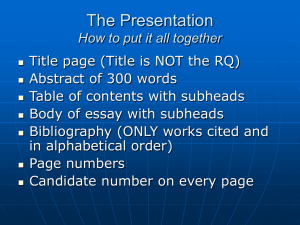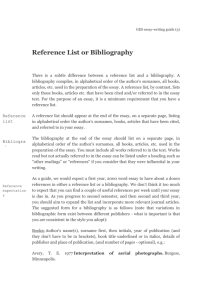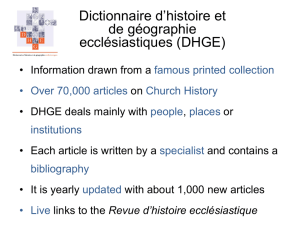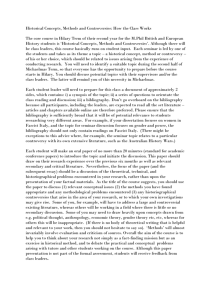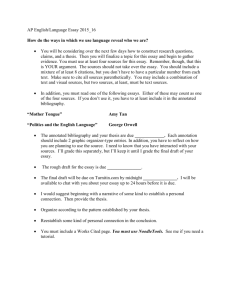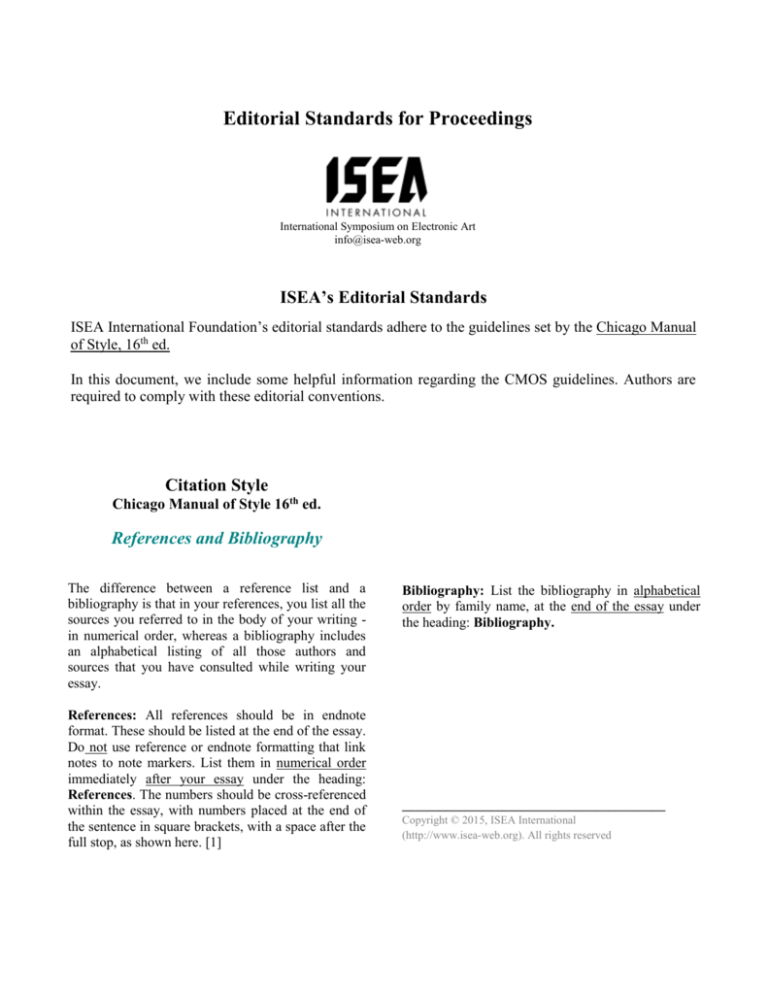
Editorial Standards for Proceedings
International Symposium on Electronic Art
info@isea-web.org
ISEA’s Editorial Standards
ISEA International Foundation’s editorial standards adhere to the guidelines set by the Chicago Manual
of Style, 16th ed.
In this document, we include some helpful information regarding the CMOS guidelines. Authors are
required to comply with these editorial conventions.
Citation Style
Chicago Manual of Style 16th ed.
References and Bibliography
The difference between a reference list and a
bibliography is that in your references, you list all the
sources you referred to in the body of your writing in numerical order, whereas a bibliography includes
an alphabetical listing of all those authors and
sources that you have consulted while writing your
essay.
References: All references should be in endnote
format. These should be listed at the end of the essay.
Do not use reference or endnote formatting that link
notes to note markers. List them in numerical order
immediately after your essay under the heading:
References. The numbers should be cross-referenced
within the essay, with numbers placed at the end of
the sentence in square brackets, with a space after the
full stop, as shown here. [1]
Bibliography: List the bibliography in alphabetical
order by family name, at the end of the essay under
the heading: Bibliography.
__________________________________________
Copyright © 2015, ISEA International
(http://www.isea-web.org). All rights reserved
References:
Style for listing references CMOS 16th ed.
Remember: List the references before the bibliography in
numerical order, with numbers cross-referenced within the
essay.
Francisco State University website, accessed January 27,
2014,
http://userwww.sfsu.edu/swilson/art/protozoagames/protog
ames10.html
Proceedings Paper Published
Books
1. Thomas H. Corman, Algorithms Unlocked (Cambridge
and London: MIT Press, 2013), 40.
11. Alvy Ray Smith, “Digital Paint Systems: An Anecdotal
and Historical Overview,” (paper based on a talk presented
at the Computer History Museum, Palo Alto, California,
January, 2000). IEEE Annals of the History of Computing,
http://design.osu.edu/carlson/history/PDFs/paint.pdf
2. Mikhail Bakhtin, The Dialogical Principle, trans. Wald
Godzich (Manchester: Manchester University Press, 1984),
56.
Dissertation or Thesis
Second and subsequent citations
3. Thomas H. Corman, Algorithms Unlocked, 15.
12. Fionnuala Fagan, “The Sound of Memory: An Artistic
Exploration of Personal and Cultural Memories of Postconflict Communities,” (Ph.D. diss., School of Creative
Arts, Queen’s University Belfast, 2013.)
Books with multiple authors
4. Martin Dodge and Rob Kitchin, Mapping Cyberspace
(London and New York: Routledge, 2001), 49.
Bibliography:
Style for listing the bibliography: CMOS 16th ed.
Edited Books
5. Alan Turing, “Computing Machinery and Intelligence,”
in The New Media Reader, ed. Noah Wardip-Fruin and
Nick Montfort (Cambridge and London: MIT Press, 2003),
50.
Remember: List the bibliography in alphabetical order by
family name, at the end of the essay.
Chapter in a single author book
Corman, Thomas H. Algorithms Unlocked. Cambridge and
London: MIT Press, 2013.
6. Geet Lovnik, “Radical Media Pragmatism (1998),” in
Dark Fiber (Cambridge and London: MIT Press, 2002),
218–225.
Journal article (print)
7. Rob Van Rijswijk and Jeroen Strijbos, “Sounds in Your
Pocket: Composing Live Soundscapes with an App,”
Leonardo Music Journal 23, (2013): 27.
Journal article (online)
Books
Bakhtin, Mikhail. The Dialogical Principle. Translated by
Wald Godzich. Manchester: Manchester University Press,
1984.
Books with multiple authors
Dodge, Martin and Rob Kitchin. Mapping Cyberspace.
London and New York: Routledge, 2001.
8. Faith Wilding, “Mujer es Revolución,” Media-N
Journal of the New Media Caucus, Vol. 09, No. 01,
accessed February 28, 2013,
http://median.newmediacaucus.org/tracingnewmediafeminisms/mujer-es-revolucion/
Edited Books
Magazines and Newspapers (online)
Lovnik, Geet. “Radical Media Pragmatism (1998).” In
Dark Fiber. Cambridge and London: MIT Press, 2002).
9. Rich Preston, “Virtual mannequins promise better fit for
online shoppers,” BBC News Technology, January 20,
2014, accessed January 27, 2014,
http://www.bbc.co.uk/news/technology-25812130
Websites
10. Stephen Wilson, “Protozoa Games (2003)”, San
Turing, Alan, “Computing Machinery and Intelligence.” In
The New Media Reader, edited by Noah Wardip-Fruin and
Nick Montfort. Cambridge and London: MIT Press, 2003.
Chapter in a single author book
Journal article (print)
Van Rijswijk, Rob and Jeroen Strijbos. “Sounds in Your
Pocket: Composing Live Soundscapes with an App.”
Leonardo Music Journal 23, (2013): 27.
Journal article (online)
Wilding, Faith. “Mujer es Revolución.” Media-N Journal
of the New Media Caucus, Vol. 09, No. 01. Accessed
February 28, 2013.
http://median.newmediacaucus.org/tracingnewmediafeminisms/mujer-es-revolucion/
Magazines and Newspapers (online)
Preston, Rich. “Virtual mannequins promise better fit for
online shoppers.” BBC News Technology, January 20,
2014. Accessed January 27, 2014.
http://www.bbc.co.uk/news/technology-25812130
Websites
Wilson, Stephen “Protozoa Games (2003).” San Francisco
State University website. Accessed January 27, 2014.
http://userwww.sfsu.edu/swilson/art/protozoagames/protog
ames10.html
Proceedings Paper Published
Smith, Alvy Ray. “Digital Paint Systems: An Anecdotal
and Historical Overview.” Paper based on a talk presented
at the Computer History Museum, Palo Alto, California.
January 2000. IEEE Annals of the History of Computing.
http://design.osu.edu/carlson/history/PDFs/paint.pdf
Dissertation or Thesis
Fagan, Fionnuala. “The Sound of Memory: An Artistic
Exploration of Personal and Cultural Memories of Postconflict Communities.” Ph.D. diss., School of Creative
Arts, Queen’s University Belfast, 2013.
Punctuation:
Some common usages
-Quotations: For direct quotations remember to use
“double inverted commas.” Quotations must be carefully
transcribed and accurate.
-Periods and commas go inside quotation marks. This
applies to “double inverted commas,” as well as single
‘inverted commas,’ and to the use of a full stop as in the
“following example.”
-Parenthesis: When an entire sentence is enclosed in
parentheses, the punctuation mark belongs inside the
closing parenthesis as in this example:
Applying this may be difficult at times. (We think it is
important.)
The punctuation mark belongs outside the closing
parenthesis if the brackets are within the sentence as in this
example:
Applying this may be difficult at times, but good results
are guaranteed (and this is important).
-Use en dashes with spaces – like this – to set off phrases.
En dashes are moreover placed between digits to indicate a
range (1–10 October; pp. 25–30). You can type an en dash
with ALT + 0150 (in the numeric keypad) in Windows, or
OPTION + HYPHEN in Mac.
For additional punctuation and grammar rules
refer to GrammarBook.com:
http://www.grammarbook.com/grammar/cnt_gram.asp
For additional examples refer to the CMOS 16th
ed. Quick Citation Guide:
http://www.chicagomanualofstyle.org/tools_citationguide.
html
__________________________________________
Copyright © 2015, ISEA International
(http://www.isea-web.org). All rights reserved

